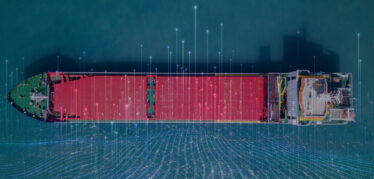Over the last several years, big data has evolved from a shiny new buzzword to a tangible business reality across sectors.
While the concept itself has been around for quite some time, big data seems to have reached its ultimate velocity only recently, as the vast majority of the world’s data has been generated within only the last few years. Now, with an unprecedented volume and velocity of data at our fingertips, it is important that we shift our sights to data intelligence: the use of contextual and actionable data to unlock real business value.
As commercial maritime shipping and logistics organizations navigate new obstacles and generate more data than ever before, they are increasingly prioritizing their data intelligence strategies, putting the people and technology infrastructure in place to accomplish their data intelligence goals.
These organizations know that by embracing a modern approach to data collection, integration, storage, standardization, and analysis, they can open the door to transformative new efficiencies within their maritime shipping workflows. While worthwhile and essential to long-term success, the journey to true data intelligence is not without its obstacles.
Let’s turn our attention to four of the most common roadblocks on the journey to data intelligence and what maritime shipping organizations can do to proactively address each of them.
Roadblock #1 – Cybersecurity
The threat of cyberattacks continues to grow with the increasing scale and value of data in the commercial maritime shipping ecosystem. Because of this, it is critical that cybersecurity be a foundational part of any maritime shipping organization’s data intelligence approach. It may be cliché, but your digital landscape truly is only as strong as your weakest link, and any weakness can pose a serious threat to your clients, your profitability, and your business.
Each and every solution provider should uphold a security-first commitment. Look for partners that make cybersecurity a top strategic priority and ensure their systems are designed safely and sensibly. Examples include 256-bit TLS encryption, encoded session identifications, multi-factor authentication, and support for single sign-on. In addition to vetting the security of outside solution providers, maritime shipping organizations should also perform critical due diligence when it comes to building an infrastructure capable of supporting tomorrow’s data intelligence requirements.
Roadblock #2 – Cross-Stakeholder Engagement
Ultimately, the success of your data intelligence strategy hinges on utilization; and utilization hinges on stakeholder buy-in.
Consider the sizeable investment you’re making in data-driven technologies that surface the insights you need. As organizations put an appropriate data framework into place, they often make the mistake of engaging only a single stakeholder group or division—or worse—neglecting to engage non-technical stakeholders altogether.
The best approach to cross-stakeholder engagement seems to be ‘early and often.’ Regularly engaging stakeholders across functions from the earliest stages of your project will ensure your data intelligence strategy includes the real, pragmatic needs of your business and secures the commitment to utilization that is needed to make any data intelligence investment pay off. Look for technology partners that are equally committed to cross-stakeholder engagement, change management, and continuing education, as these pillars can make or break the return on your data intelligence investment. This is not a process that ends with go-live—it is a journey that continues to evolve with the needs of your maritime shipping users.
Roadblock #3 – Data & Process Standardization
As the old data adage goes, “garbage in, garbage out.” Your data intelligence efforts depend on your ability to gather and maintain data that are clean, structured, standardized, and scalable.
But standardization not only applies to data. It also applies to the processes that are responsible for collecting the data, which must be carefully standardized across individual team members in order to generate data records with the highest integrity and quality. Contextual, inter-workflow insights are built upon a critical foundation of data and process standardization.
For the ultimate standardization and scalability, look for a platform that is capable of unifying disparate functions of your business into one connected workflow that establishes a single source of truth. Look for partners that are reimagining data collection, cross-stakeholder collaboration, and information sharing—all while progressing data standardization best practices industry-wide. It goes without saying that data standardization should encompass all of your mission-critical information—past, present, and future—from providing centralized access to historical records to generating contextual and predictive insights in real-time.
Roadblock #4 – Systems Integration
Imagine establishing a robust approach to cybersecurity, ensuring your stakeholders are engaged and empowered, and standardizing your data and processes within your workflow—only to be hindered by costly information gaps from outside systems and data sources.
It’s tantamount to building a city but forgetting the roads. And yet, seamless systems integration remains a key obstacle for so many organizations. It is important to note that this issue persists across internal technologies—like accounting systems, ERPs, and CTRMs—as well as external data sources—like linked indices, bunker prices, and weather feeds.
To ensure your data intelligence efforts aren’t hindered by integration limitations, look for a partner that is known for its strength and flexibility in system integration, one that has a robust track record of system-agnostic integration work, and one that lets your needs dictate integration requirements rather than the other way around. Specifically, your partner should provide a dynamic combination of native product integrations and flexible APIs that enable you to design your own journey and ensure cross-system continuity well into the future—even as you adopt new digital solutions.
Embrace True Data Intelligence
As commercial maritime shipping and marine logistics organizations move to develop and evolve their data intelligence strategies, the commercial platform they use is among the most important choices they will make. With a robust security approach, a commitment to user engagement and education, deep expertise and capabilities in data and process standardization, and a robust track record of system integration, Veson and the Veson IMOS Platform (VIP) possess all of the characteristics needed to surmount data intelligence hurdles and accelerate data-driven success.
If you’re looking to learn more about the transformative role data can play in commercial maritime shipping and logistics, we invite you to read our Data Intelligence Brief below. If you’d like to tell us a little bit more about your own data journey, we invite you to connect with a member of our team.



 Ayodele Fashakin
Ayodele Fashakin
 Ben Thurecht
Ben Thurecht
